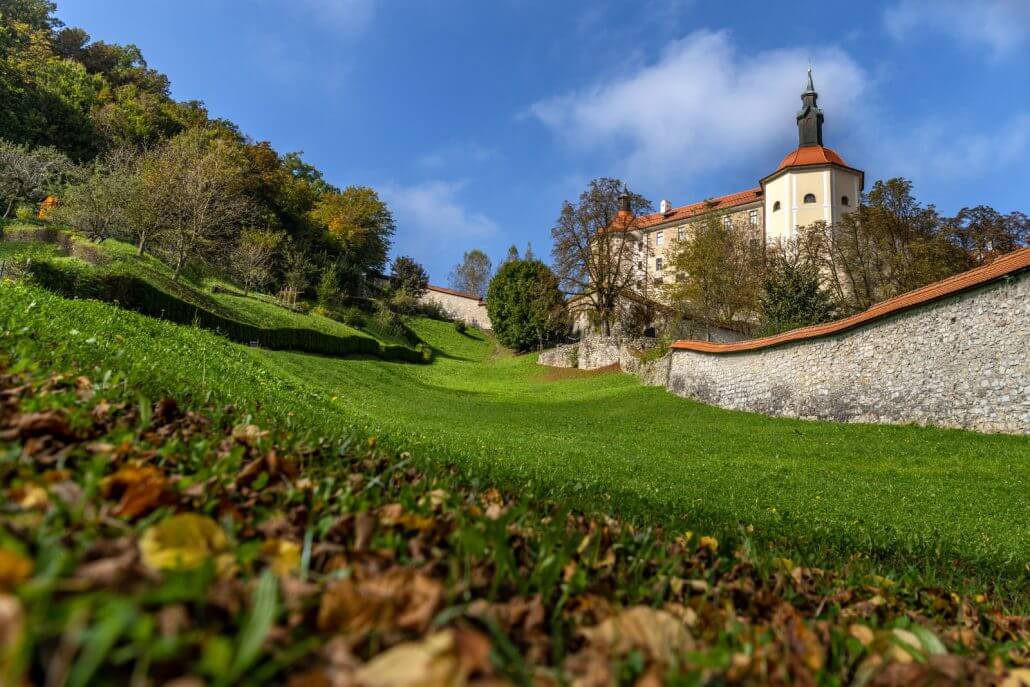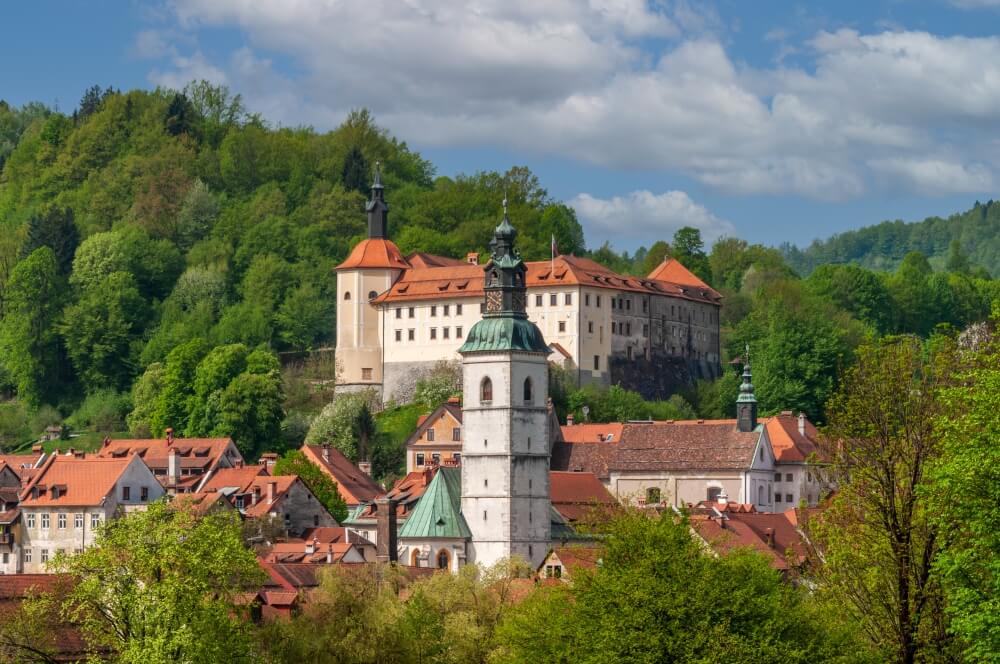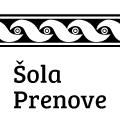The venue of the largest baroque performance
The streets of Škofja Loka are the venue of the Škofja Loka Passion Play, the first Slovenian dramatic text, which comes to life every few years as the largest outdoor theatre performance. Thousands of people take part in the living masterpiece, which is included on the UNESCO World Heritage list. A walk through one of the best preserved medieval towns in Europe is always a journey into passion times.
From now until then: half a milenium back
In the medieval core of Škofja Loka, the best starting point for your journey is Mestni trg square. At the Tourist Information Centre (1), arrange for a guided tour of the town and the wider area, or get your first impressions on your own. From here, take the circular route from one landmark to another. On Cankarjev trg square in the immediate vicinity, the Church of St. Jacob (2), built in 1471 on the foundations of a church at least two centuries older, invites you to mystical and spiritual paths through the centuries.
A Tip: The Škofja Loka Passion Play is inextricably linked to the spiritual life of Slovenes. The sacral heritage of the Škofja Loka area invites you to the nearby Crngrob, where there is one of the most beautiful medieval churches in Slovenia. Its beginnings date back to the 13th century, and one of the many thematic paths leads to it.
(From here to the next point: 5 minutes.)
A market of abundance and art
The Škofja Loka area is famous as a place of creativity and art. At Spodnji trg square, connoisseurs and lovers of fine arts like to enter the Gallery of France Mihelič (3), the original Slovenian master of surrealist figurative painting, by prior arrangement.
The gallery is located in one of the most important buildings of the landlords who owned the town in the Middle Ages – in Kašča (4). It stored crucial town’s supplies, as the tributes of the subjects were stored in the building.
A Tip: There is a renowned local inn in the Kašča cellar.
(Recommended time for a stop: 30 minutes. You need 5 minutes to the next point.)
Market of handicraft and public life
The locals like to go to Mestni trg square with the Town Hall (5), a former town house from the 16th century, because of the popular café and confectionery, which is located in the striking Homan’s House (6). The ancient bourgeois mansion, renovated after a major earthquake more than 500 years ago, still shows its Gothic style with a few Renaissance elements. The square is also home to an old rectory (7) with pilasters and a two-coloured façade, which indicates the merging of two buildings. Among the most attractive points of the square, which has been the centre of public life of the town and its guild craftsmen for centuries, is the DUO Arts and Crafts Centre (8). It features products by local artisans. The centre occasionally organizes workshops to learn master skills. Among the many specialties of the area is also a small Loka bread (9).
(Recommended time for a stop: 45 minutes. From here to the next point: 10 minutes.)
Castle gardens and chambers of heritage
From Trg pod gradom square, head to Loka Castle (10), built in 1202 and rebuilt after the earthquake in 1511. Škropar’s House (11), a beautifully preserved farm building from the 16th century, is preserved in the castle park. The collections of the Loka Museum (12), which present the cultural heritage of the area between the Selška and Poljanska Sora Rivers (13), are on display in the castle. Here you can also get to know the Škofja Loka Passion Play in more detail (14).
A Tip: All four main squares are also stages for the Škofja Loka Passion Play. This is pointed out by the tiles with the symbol of Passion Play on the ground. They mark Romuald’s path. Find the application for it on your mobile phone.
(Recommended time for a stop: 60 minutes. From here to the next point: 10 minutes.)
At the origin of Passion Play
When you descend from the castle hill back to the town, head for the Stone Bridge (15)also called the Capuchin Bridge. Not far from it is the Capuchin monastery with a library (16), which keeps some of the oldest books in Slovenia. Among them is the original of the Škofja Loka Passion Play (14). Guided tours are available by appointment at the Škofja Loka Tourist Information Centre.
Suggestion for a hike
On the path of three castles
From Loka Castle, head to the scenic and green surroundings of the town along the Path of Three Castles, which is marked by the image of a medieval page. From the castle walls, it directs you uphill, towards the ruins of the Tower on Krancelj. An information board on nearby Štajgrof presents the nearby and more distant peaks of the hiker-friendly Škofja Loka hills.
The path then descends towards a farm with two natural sights nearby – Mary’s and Migut’s chasm. Signposts direct you to the walking trail, which was being arranged at the end of the 19th century. Follow the symbol of the page through the forest as far as Kobila and to the ruins of Divja Loka Castle. The castle on the steep slope of Lubnik had excellent natural protection. Through Vincarška grapa gorge we return back to our starting point in the town.
More information: Škofja Loka TIC

1. TIC – Tourist Information Centre Škofja Loka
Mestni trg square is similar to a widened road that narrows like a funnel in the south direction. In the past, it was the centre of economic and social life. Both sides of the square are lined with buildings with Gothic or Baroque portals, with colourful facades and arcaded courtyards. Mestni trg 42 is home to the Tourist Information Centre, where you can get all the information about the town and the Škofja Loka area, arrange guided tours and choose from various souvenirs.
Mestni trg 42, T: 04 620 22 01
2. St. Jacob's church
See the reliefs of guilds and altar patrons in the parish church on the picturesque Cankarjev trg square. Look at the ceiling with 16th century frescoes painted by Jernej from Loka. Worthy of special mention is the black marble Renaissance altar of St. Catherine from 1694 and the picture of Christ on the Mount of Olives dating from the end of the 17th century. The interior of the church, the altars and the chandeliers were remodelled according to a plan by the architect Jože Plečnik.
Cankarjev trg 13, T: 04 512 06 72
3. Gallery of France Mihelič
The gallery in the striking building of the former Kašča (Granary) on Spodnji trg square presents an oeuvre of France Mihelič, the most prominent Slovenian master of surrealist figurative painting, which he left to his hometown of Škofja Loka. The collection includes his graphics, drawings and paintings. Most of the works are from the 1970s and from his famous thematic opuses: Dafne, Kurent, Clocks and Musicians. The gallery is open by prior arrangement.
Spodnji trg 1, T: 04 517 04 00
4. Granary
The granary is one of the oldest buildings in Škofja Loka. It was erected before the earthquake that changed the town in 1511. By order of Bishop Filip, whose coat-of-arms can be seen on a late Gothic relief plate, the town was thoroughly renovated. Next to the castle, the granary was the most important building of the landlords, as all tributes were stored in it. A special bishop’s official – kaščar (a granary man), managed the granary, which was then part of the town walls.
Spodnji trg 1
5. Town Hall
The former town hall from the 16th century was once the seat of representatives of public life in Loka, headed by a town judge. The painted and architectural elements of the building point to an important place in history at every step. Baroque frescoes, paintings of pillars, flowers and various figural details are visible on the façade.
Mestni trg 35
6. Homan's house
After the earthquake of 1511, the burgher mansion was renovated in the Gothic style with a few Renaissance elements. At the time of the restoration of the exterior, the frescoes of a medieval soldier and St. Christopher as well as some other ornaments from the 16th century came to light. At the turn of the 19th and 20th centuries, the painter – impressionist Ivan Grohar, frequented the inn above the pastry shop. You can also find his gallery at Mestni trg 37.
Mestni trg 2
7. The old rectory
Pilasters and a two-coloured facade prove that the building was originally composed of two houses, and was reconstructed between the years 1740 – 1760. Outside, there is a Renaissance plaque with a coat-of-arms of the rich and influential townsman Volbenk Schwarz, the founder of the Holy Trinity beneficium, who built a chapel in his house in 1513. The entrance portal is made from stone, the hall is cross vaulted, and the staircase is surrounded by a Baroque wrought-iron grid.
Mestni trg 38
8. DUO Arts and Crafts Centre
The centre of arts and crafts preserves the rich Škofja Loka artisan tradition. The masters organized in guilds had a strong influence on the medieval prosperity of the city. Here you can buy fair trade handicraft masterpieces bearing the Art & Craft Slovenija certificate ensuring top quality. You can also attend various handicraft workshops or watch the work of a local artisan live.
Mestni trg 34, T: 04 51 12 460
9. Škofja Loka small bread
Small Loka bread was made in the 18th century by the Clarisa nuns. Its ingredients have remained the same ever since – flour, honey and various spices. This honey bread was considered a wedding and love cake. Today, it is also baked on other occasions. In Škofja Loka, a hand-carved wooden mould is used to make an imprint in the honey dough.
10. Loka castle
Loka Castle, first mentioned in 1215 , was the seat of the Loka lordship. Beneath it, a settlement of craftsmen and merchants was formed as early as the 13th century. The castle was almost completely destroyed in the earthquake of 1511, and Bishop Filip had it rebuilt. In the castle courtyard there once stood an impressive four-cornered tower, the floorplan of which has been restored. Today, the collections of the Loka Museum are on display in the castle.
Grajska pot 13, T: 04 517 04 00
11. Škopar's house
One of the first open-air museums has been arranged in the castle garden since 1962. You can see Škopar’s House with a typical wreath kitchen from the 16th century, a haystack and a mill. The museum presents the living culture of small farmers in the wider Loka area in the period from the 16th to the end of the 19th century.
Loka castle garden, Grajska pot 13, T: 04 517 04 00
12. Loka museum Škofja Loka
The mighty Loka Castle is home to one of the most visited museums in Slovenia. Its diverse collections present the cultural and natural heritage of the former Loka lordship. You can learn about the origins and development of the town of Škofja Loka. Ethnological collections give an insight into everyday life and festive days in the past, the guild collections reveal the rich heritage of Loka artisans, and the Škofja Loka Passion Play collection presents the most famous town event and the importance of intangible heritage under the protection of UNESCO.
Grajska pot 13, T: 04 517 04 00
13. The Selška and Poljanska Sora rivers
The old town of Škofja Loka is located at the confluence of the Selška and Poljanska Sora Rivers. The Selška Sora, which springs above the village of Zgornja Sorica, is the main watercourse in the northern part of the Škofja Loka hills. It is an interesting fishing river. In the past, it was an important source of hydropower, too. The Poljanska Sora springs as a stream in the northern part of the Rovtar hills and is the main watercourse in the southern part of the Škofja Loka hills. Both Sora Rivers are interesting fishing rivers. The confluence of the rivers is a popular promenade.
14. Škofja Loka Passion Play
The Škofja Loka Passion Play – Processio locopolitana – is the oldest preserved dramatic work in the Slovenian language and the oldest surviving European director’s book, the only one from the Baroque period. It was written around 1715 by Father Lovrenc Marušič i.e. Father Romuald. The Passion Play is designed as a procession in 13 tableaux. The staging on the streets and squares of medieval Škofja Loka, where thousands of participants perform every six years, was the first from Slovenia to be inscribed on the UNESCO list of intangible cultural heritage of mankind.
15. The stone or Capuchin bridge
The bridge over the Selška Sora River, built in the middle of the 14th century from cut stone in semicircular shape, is one of the oldest monuments of its kind in Central Europe. In 1888, it was restored and an iron fence was added. In the middle of it is a statue of St. John of Nepomuk, with the Loka coat-of-arms on the pedestal. In the Middle Ages, the Selška gate with a watchtower stood by the bridge.
Kapucinski trg
16. Capuchin church with monastery and library
The greatest treasure of the Capuchin complex, built in the Baroque period in 1709, is the library, which, in addition to incunables and old religious books, keeps a valuable manuscript of the Škofja Loka Passion Play. There is also a permanent exhibition on the Passion Play in the library, which can be entered as part of guided tours.
Kapucinski trg 1, T 04 506 3000
- 11. TIC – Tourist Information Centre Škofja Loka
- 22. St. Jacob's church
- 33. Gallery of France Mihelič
- 44. Granary
- 55. Town Hall
- 66. Homan's house
- 77. The old rectory
- 88. DUO Arts and Crafts Centre
- 99. Škofja Loka small bread
- 1010. Loka castle
- 1111. Škopar's house
- 1212. Loka museum Škofja Loka
- 1313. The Selška and Poljanska Sora rivers
- 1414. Škofja Loka Passion Play
- 1515. The stone or Capuchin bridge
- 1616. Capuchin church with monastery and library





